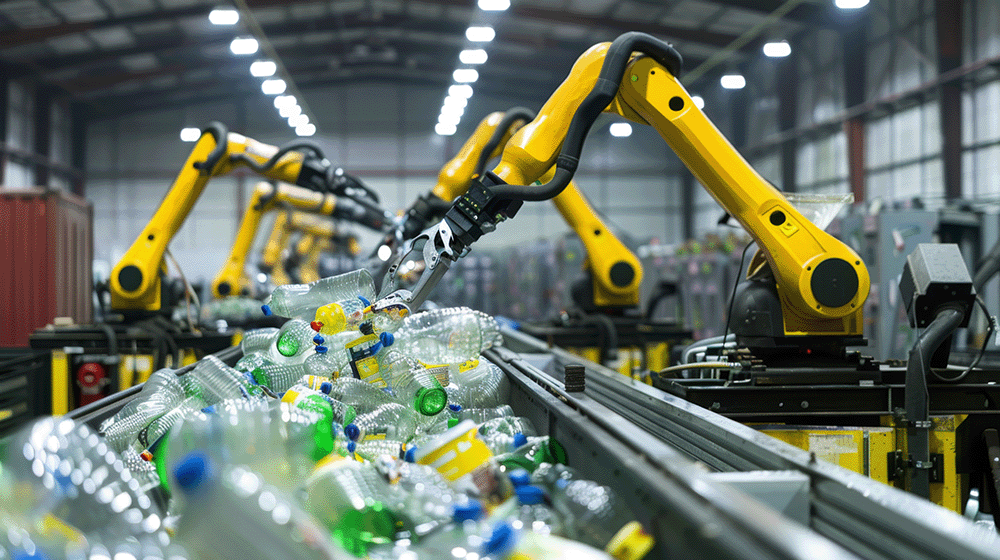
Most people still think of recycling the same way they did twenty years ago, tossing bottles and cans into blue bins and hoping for the best. But behind the scenes, something remarkable is happening. Recycling facilities are becoming high-tech operations where robots sort materials faster than human hands ever could, and smart sensors tell garbage trucks exactly when bins need to be emptied. From artificial intelligence, sorting through mountains of recyclables to sensors monitoring bin levels in real-time, data-driven solutions are addressing long-standing challenges that have plagued recycling efforts for years.
Smart Sensors Transform Collection and Monitoring
The most significant change currently involves installing smart sensors inside recycling bins. You’ve probably never noticed them, but these little devices are quietly changing how garbage collection works. They keep track of how much space is left in each bin and send that information back to the companies that empty them.
Take Bintel, a Swedish company that has figured out how to put tiny sensors in trash bins that can send signals regarding their level of fullness. These sensors don’t require fancy wiring or an expensive setup; they simply work. Before this technology existed, garbage trucks would drive the same routes every week, whether the bins were full or empty, which was quite wasteful when you think about it. Now, trucks can show up only when bins are getting full. It’s like having your trash can text you when it needs attention, except the message goes to the waste company instead.
These sensors reduce gas costs, meaning fewer trucks will be rumbling through neighborhoods unnecessarily. Additionally, people won’t have to deal with overflowing bins.
All this sensor data tells a story about how people dispose of stuff. Waste companies can spot patterns, such as how certain neighborhoods generate more recycling during the holidays or which areas consistently fill up faster than expected. Municipalities can identify which areas generate more recyclables during specific times of the year, enabling them to allocate resources accordingly. This predictive capability enables cities to become more responsive to their communities’ actual recycling needs, rather than relying on historical averages.
AI-Powered Sorting Revolutionizes Material Recovery
The most dramatic transformation is occurring inside material recovery facilities, where artificial intelligence and robotics are automating the tedious and sometimes hazardous work of sorting recyclables. Companies such as AMP Robotics, Glacier, and EverestLabs have developed sophisticated systems that combine computer vision with robotic arms to identify and separate materials with remarkable precision.
These AI-powered robots can process up to 80 items per minute while maintaining accuracy rates between 80% and 90%. Unlike human workers who may become tired and make errors, these systems operate consistently throughout their shifts without tiring. The robots utilize spectral imaging to detect a unique infrared signature of each item, recognizing different types of plastics, paper, metals, and glass.
What makes this technology particularly valuable is its ability to adapt and learn. Recycling facilities report that robots take about three months to “learn” the specific characteristics of materials in their waste stream, but become increasingly accurate over time. This learning capability enables the systems to adapt to regional differences in recyclable materials and packaging.
The impact on worker safety cannot be overstated. Waste facilities that have incorporated AI report a 35% decrease in worker injuries, while also addressing the industry’s chronic labor shortage problems. Rather than eliminating jobs, these systems often allow humans to focus on higher-value tasks while robots handle the most repetitive and hazardous sorting work.
Data Analytics Drive Circular Economy Innovation
Beyond collection and sorting, data analytics are enabling new approaches to the circular economy. Advanced tracking systems allow companies to understand precisely what types of materials flow through their facilities, identifying opportunities to capture value that might otherwise be lost.
Approximately 30% of potentially recyclable and valuable materials are lost at sorting facilities due to inefficiencies and contamination. Data-driven systems help facilities track these losses in real-time, allowing operators to adjust processes and recover more materials. This granular visibility also enables better quality control, producing purer material streams that command higher prices from buyers.
Some facilities are using this data to work backward with manufacturers, providing feedback about which packaging designs work well in recycling systems and which create problems. This information creates a feedback loop that can influence product design at the source, making items more recyclable from the start.
Blockchain Enables Transparency and Traceability
Emerging blockchain technologies are adding another layer of sophistication to recycling systems by creating tamper-proof records of material flows. While still in early stages, these systems could eventually track recyclable materials from their initial use through collection, processing, and transformation into new products.
This transparency addresses growing consumer and regulatory demands for accountability in recycling claims. Companies can demonstrate that materials, which are marked as recyclable, complete the recycling loop rather than ending up in landfills.
Challenges and Future Opportunities
Despite these advances, challenges remain. Integration between different technological systems can be complex, and the upfront costs of implementing smart recycling infrastructure require significant investment. However, the global recycling robot market is projected to grow from $202.54 million in 2024 to $673.21 million by 2032, indicating strong industry confidence in these solutions.
Looking ahead, the convergence of AI, IoT, and blockchain technologies promises even more sophisticated recycling systems. We’re moving toward a future where every piece of recyclable material can be tracked, sorted, and processed with minimal human intervention, while maximizing recovery rates and material quality.
The transformation from traditional recycling to data-driven systems isn’t just about efficiency; it’s also about fundamentally reimagining how we handle resources in a circular economy. As these technologies mature and costs decrease, we can expect to see them deployed more widely, bringing advanced recycling capabilities to communities of all sizes. The result will be recycling systems that are not only more effective but also more responsive to the real-world challenges of managing our growing waste streams.